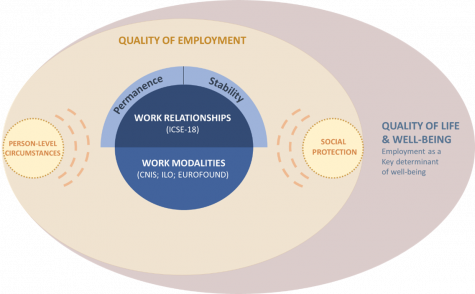
Conceptual Framework on Forms of Employment
- Employment and jobs
-
The Conceptual Framework on Forms of Employment starts from the concept of employment.
According to the Resolution concerning statistics on work, employment and labour underutilization of the 19th International Conference of Labour Statisticians (ICLS), employment is defined as work performed in return for pay or profit, which reflects the fact that the intention of activities defined as employment is to receive remuneration in some form.
Further, the concept of a job describes the activities performed and their characteristics in relation to employment. A job is defined as a set of tasks and duties performed (or meant to be performed) by one person for a single economic unit in relation to activities defined as employment.
The Conceptual Framework on Forms of Employment aims to classify jobs based on a two-dimensional approach which reflects the distinction between work relationships and work modalities.
- Work relationships and modalities
-
Work relationships refer to the relationship between workers and the economic unit for which they work. According to the International Labour Organization (ILO) “statistics on work relationships provide important information on the nature of the economic risk and authority that individuals experience at work, and on the strength and nature of the attachment of workers to the economic units in which or for which they work.”
The international statistical standard for statistics on work relationships is the International Classification of Status in Employment 2018 (ICSE-18). ICSE-18 includes two classifications: ICSE-18-R which classifies work relationships according to the type of economic risk and ICSE-18-A which classifies work relationships according to the type of authority.
Work modalities refer to the ways in which work is coordinated, performed, and compensated over time and space. There is no international statistical standard governing this concept. However, it is based on Eurofound’s concept of “work patterns” and the notion of the “modalities of the performance of employment” put forward by the Conseil national de l’information statistique (CNIS) in France to describe phenomena which relate to the way in which work is conducted.
- Other Dimensions
-
Alongside the central considerations of work relationships and work modalities, four additional dimensions help support a comprehensive Conceptual Framework for measuring forms of employment and understanding their impact on well-being:
(1) the level of permanence and stability associated with work relationships;
(2) the social protection system in which the form of employment is found;
(3) the circumstances of persons who are employed in the form of employment; and
(4) the impact of forms of employment on individual well-being, as captured by the broader concept of quality of employment.
- Illustration
-

To better understand how to use the Conceptual framework, see: How to measure forms of employment and understand their impact
Handbook on Forms of Employment
-
Chapter 6 Measuring interactions with personal circumstances
-
Annex C: Possible combinations of work relationships and work modalities
Bibliography
Conseil national de l’information statistique (CNIS). (2016). La diversité des formes d’emploi,
No. 142. Retrieved from https://www.cnis.fr/wpcontent/uploads/2017/10/RAP_2016_142_diversite_fo…
Eurofound. (2015). New Forms of Employment. Publications Office of the European Union,
Luxembourg. Retrieved from
https://www.eurofound.europa.eu/sites/default/files/ef_publication/fiel…
Eurofound. (2020). New forms of employment: 2020 update. New Forms of Employment
Series. Publications Office of the European Union, Luxembourg. Retrieved from
https://www.eurofound.europa.eu/sites/default/files/ef_publication/fiel…
ILO. (2013). Resolution concerning statistics of work, employment and labour underutilization.
Adopted by the 19th International Conference of Labour Statisticians, Geneva, 2–11 October
2013. Retrieved from https://www.ilo.org/wcmsp5/groups/public/---dgreports/---stat/documents…
ILO. (2018). Resolution concerning statistics on work relationships. Adopted by the 20th International Conference of Labour Statisticians, Geneva, 10–19 October 2018. Retrieved from https://www.ilo.org/wcmsp5/groups/public/---dgreports/---stat/documents…
ILO. (2020). Update: Conceptual Framework for Statistics on Work Relationships. International Labour Office, Geneva. Retrieved from https://www.ilo.org/wcmsp5/groups/public/---dgreports/---stat/documents…